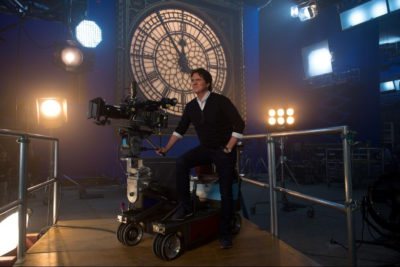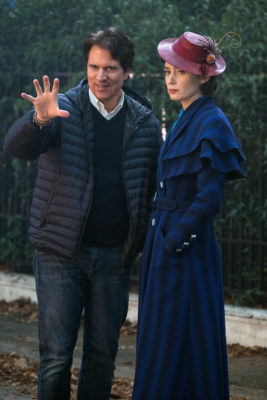Rob Marshall: The Real-Life Mary Poppins
 The world had to wait thirty years between the first published Mary Poppins book and a worthy screen adaptation that could elevate the P.L, Travers stories into a cinematic masterpiece. The only person who could have assembled the right pieces to create this masterpiece was Walt Disney. It’s been fifty-four years since the Academy Award-winning Mary Poppins left a large imprint on pop culture and it would be foolish of any filmmaker to try to produce a follow-up. But if you’re a real-life Mary Poppins, it's a challenge that could be conquered with a cheery disposition and a practically perfect outlook on life.
The world had to wait thirty years between the first published Mary Poppins book and a worthy screen adaptation that could elevate the P.L, Travers stories into a cinematic masterpiece. The only person who could have assembled the right pieces to create this masterpiece was Walt Disney. It’s been fifty-four years since the Academy Award-winning Mary Poppins left a large imprint on pop culture and it would be foolish of any filmmaker to try to produce a follow-up. But if you’re a real-life Mary Poppins, it's a challenge that could be conquered with a cheery disposition and a practically perfect outlook on life.
Producer John De Luca has had the privilege of working with Director Rob Marshall since his meteoric rise to fame as the director of Chicago. “He’s so unselfish in his care of people and the art of making movies that no matter how huge the pressures are, we walk onto the set, we walk into any area where the actors or the crew or the people working for him are and he just has this way of turning on this positive energy that’s all about them and it’s all about you. It’s all about taking care and nurturing and so ‘Mary Poppins.’ I feel that this was not only the right time but it’s the right time because the right man was here to share his vision with the world. I think it’s just the perfect time because Rob was here to make it.”
Emily Mortimer steps into the role of Jane Banks grown up and had similar feelings about the man in charge of this production. “It was a slight of hand of Rob’s where he is the puppet master and he’s absolutely kind of Mary Poppins himself, he is Mary Poppins, he is Mary Poppins without the parrot… but he manages to just sort of know what to do without sort of worrying about it and he’s protecting you from all the anxiety and the stress and the burden of knowing that this is such a huge thing and this is such a huge legacy and we’re in charge of it and none of that came into it. It was just we’ve got to do this, we’ve got to have fun doing this, we’ve got to do right by this in the best, sweetest way and it was just a joy.”
 When assembling his cast and creative team, Rob Marshall had one requirement. “I really felt like everyone who was a part of this needed to have the first film in their blood in some way because that’s what we were following… I use myself as a barometer; I have to say, because I thought what would I want to see? If I came to a sequel to Mary Poppins I would want to see an animated sequence with live action. And I would want it to be hand drawn in a 2D world. I would want to see that. I would want Cherry Tree Lane to have a curve to it because that’s the Cherry Tree Lane we all know. I would feel disappointed if it was a straight street. I mean it was as simple as that, although we were finding our own way.”
When assembling his cast and creative team, Rob Marshall had one requirement. “I really felt like everyone who was a part of this needed to have the first film in their blood in some way because that’s what we were following… I use myself as a barometer; I have to say, because I thought what would I want to see? If I came to a sequel to Mary Poppins I would want to see an animated sequence with live action. And I would want it to be hand drawn in a 2D world. I would want to see that. I would want Cherry Tree Lane to have a curve to it because that’s the Cherry Tree Lane we all know. I would feel disappointed if it was a straight street. I mean it was as simple as that, although we were finding our own way.”
One of the biggest differences from the original film is the look, due largely to a different approach to bringing the Banks family’s world to life. “I was so anxious and excited to film on location. I mean, [Lin-Manuel Miranda] drives by Saint Paul’s, that is Saint Paul’s Cathedral. And of course in the first film it’s that beautiful Peter Ellenshaw painting. And because we were setting this in the 30’s in a more real time, I really love the juxtaposition between the real world that we were shooting and this real family. I wanted you to really connect emotionally to these people and know that they were real and then these fantasias and adventures that Mary Poppins takes them on, that we can go so many places and come back to this real world and the hope for me was that by the end of the film they combine, they collide.”
Walt Disney famously talked about how jubilant and happy the atmosphere on the set of the original film was. That same spirit was alive on Mary Poppins Returns and the cast and crew had an original cast member on the set to confirm the feeling. Dick Van Dyke has a cameo in the film and Rob Marshall reflected on working with the Disney Legend. “He grabbed my hand as we walked onto the set and he turned to me and he said something I will never forget. He said ‘I feel the same spirit here on this set that I did on the first film.’ And that was, you know, that was a dream come true right there.”
Emily Blunt shared her first conversation with Rob Marshall about the project. “When [Rob] said Mary Poppins I felt like the air changed in the room, it was such an extraordinary rather unparalleled moment for me because I was filled with an instantaneous yes, but also with some trepidation all happening simultaneously in that moment because she is so iconic, she had such a big imprint on my life and on everyone’s lives. People hold this character so close to their hearts.”
 While Julie Andrews’ performance is unforgettable, Emily Blunt’s portrayal likely would have garnered more praise from author P.L Travers. “I found the books to be a huge springboard and enormously helpful,” Blunt explained. “She leapt off the page at me just in how complicated she is, how unknowable she is in this wonderful way. That duality of the character, that she is stern and she is incredibly rude and vain but like funny, and yet there is this humanity. And she has to herself have such a childlike wonder in her in order to want to infuse these children’s lives with it. And there must under there be a generosity of spirit to want to fix and heal in the way that she does.”
While Julie Andrews’ performance is unforgettable, Emily Blunt’s portrayal likely would have garnered more praise from author P.L Travers. “I found the books to be a huge springboard and enormously helpful,” Blunt explained. “She leapt off the page at me just in how complicated she is, how unknowable she is in this wonderful way. That duality of the character, that she is stern and she is incredibly rude and vain but like funny, and yet there is this humanity. And she has to herself have such a childlike wonder in her in order to want to infuse these children’s lives with it. And there must under there be a generosity of spirit to want to fix and heal in the way that she does.”
In the same way that “Feed the Birds” struck the biggest emotional chord in the original film, a song called “The Place Where Lost Things Go” is likely to have the biggest impact on audiences. Lyricist Scott Wittman described how the books inspired this memorable moment in the sequel. “In one of the books, Mary’s uncle is the man on the moon and she takes the children there for a tea party. But on the other side of the moon he tells her that this is the place where the things people can’t find live. The dark side of the moon, and not in the Pink Floyd way, but that seemed to be a good metaphor for loss to sing to the children.”
The song is an impactful piece that only a character like Mary Poppins could pull off. “These children in the film, their sense of loss and that they’re trying to hold their father together and they’ve dealt with something so profound and so agonizing to lose a parent,” Emily Blunt explains. “And to be so young and to miss her so much, oh my God I’m going to cry thinking about it… She recognizes what they need in that moment and gives it to them in this very tender way and the song is so true and she doesn’t shy away from the fact that they’ve lost something, but there’s cracks of light, you know, and there’s something to learn from. And the idea of loss being something that they can digest as children and to walk through, that you are going to walk through this loss and nothing’s gone forever, only out of place. It’s just such a hopeful way to look at loss really.”
In the original film, Mary Poppins helped George Banks by giving him the ability to connect with his kids and the world around him. In the sequel, Michael Banks needs her to help his family heal after a great loss and to remind him of life’s simple pleasures. “It’s in the P.L. Travers books,” Rob Marshall reveals. “It’s about finding that childlike joy in life, which to some might sound trivial but to me its very profound. And I honestly was able to explore that idea in making this film, It was incredibly hard work, probably the hardest I’ve ever had to do on a film, but at the same exact time incredibly joyous for that very reason.”
Mary Poppins Returns glides into theaters on December 19th. The quotes in this article are from the Press Conference that was held on November 28th. You can watch the entire conference below.
Costumes from the film were also on display at the press conference. For more great Disney coverage, be sure to subscribe to Laughing Place’s YouTube channel.


